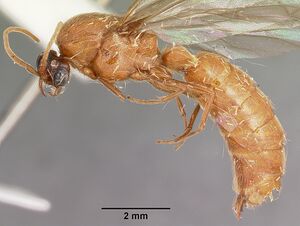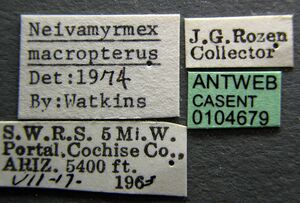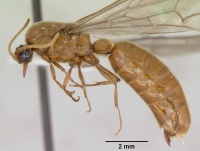Neivamyrmex fuscipennis
| Neivamyrmex fuscipennis | |
|---|---|

| |
| Scientific classification | |
| Kingdom: | Animalia |
| Phylum: | Arthropoda |
| Class: | Insecta |
| Order: | Hymenoptera |
| Family: | Formicidae |
| Subfamily: | Dorylinae |
| Genus: | Neivamyrmex |
| Species: | N. fuscipennis |
| Binomial name | |
| Neivamyrmex fuscipennis (Smith, M.R., 1942) | |
| Synonyms | |
| |
Collected in creosotebush scrub and desert riparian canyons with oaks, pines and junipers. The habits of this ant are unknown, except that males are attracted to lights. Flights occur from May to August.
Identification
Smith (1942) - The male of fuscipennis can be distinguished by its rather small size; slender form; long, curved, very acutely tapering mandible; strongly projecting posterior corner of the head; subfiliform antennal funiculus; faintly toothed tarsal claws; deeply infuscated wings; and yellowish-brown body with blackish head. This species might be confused with Neivamyrmex melshaemeri, to which it bears a resemblance in size, form, protuberant posterior corners of the head, and the shape of the mandibles. It can be very easily distinguished from melshaemeri, however, by its larger size, longer mandibles, deeply infuscated wings, and much shorter pilosity.
Distribution
United States: KS, TX (eastern), NM and AZ (Chiricahua Mts.). Mexico: Chihuahua, Durango, Oaxaca, Puebla.
Latitudinal Distribution Pattern
Latitudinal Range: 34.156971° to 15.74105°.
| North Temperate |
North Subtropical |
Tropical | South Subtropical |
South Temperate |
- Source: AntMaps
Distribution based on Regional Taxon Lists
Nearctic Region: United States (type locality).
Neotropical Region: Mexico.
Distribution based on AntMaps
Distribution based on AntWeb specimens
Check data from AntWeb
Countries Occupied
| Number of countries occupied by this species based on AntWiki Regional Taxon Lists. In general, fewer countries occupied indicates a narrower range, while more countries indicates a more widespread species. |

|
Estimated Abundance
| Relative abundance based on number of AntMaps records per species (this species within the purple bar). Fewer records (to the left) indicates a less abundant/encountered species while more records (to the right) indicates more abundant/encountered species. |

|
Biology
Castes
Male

| |
| Male (aedeagus). Photographer Gordon Snelling. | |
Images from AntWeb
 
| |
| Male (alate). Specimen code casent0103460. Photographer April Nobile, uploaded by California Academy of Sciences. | Owned by LACM, Los Angeles, CA, USA. |
    
| |
| Paralectotype of Neivamyrmex fuscipennis. Male (alate). Specimen code casent0103461. Photographer April Nobile, uploaded by California Academy of Sciences. | Owned by LACM, Los Angeles, CA, USA. |
     
| |
| Male (alate). Specimen code casent0104679. Photographer April Nobile, uploaded by California Academy of Sciences. | Owned by AMNH, New York, NY, USA. |
Nomenclature
The following information is derived from Barry Bolton's Online Catalogue of the Ants of the World.
- fuscipennis. Eciton (Neivamyrmex) fuscipennis Smith, M.R. 1942c: 578, pl. 4, fig. 15 (m.) U.S.A. (Texas) (attributed to Wheeler, 1908e).
- Type-material: lectotype male (by designation of Watkins, 1975d: 89).
- [Note: Smith, M.R. originally recorded 17 syntype males in USNM.]
- Type-locality: lectotype U.S.A.: Texas (G.W. Belfrage).
- Type-depository: USNM.
- [Acamatus fuscipennis Wheeler, W.M. 1908e: 417. Nomen nudum (attributed to Cresson).]
- Combination in Neivamyrmex: Borgmeier, 1953: 18.
- Status as species: Creighton, 1950a: 71; Smith, M.R. 1951a: 780; Borgmeier, 1955: 642 (redescription); Smith, M.R. 1958c: 109; Smith, M.R. 1967: 345; Watkins, 1972: 351 (in key); Watkins, 1975d: 85; Watkins, 1976: 23 (in key); Smith, D.R. 1979: 1330; Watkins, 1982: 213 (in key); Watkins, 1985: 484 (in key); Bolton, 1995b: 289; Mackay & Mackay, 2002: 56; Snelling, G.C. & Snelling, 2007: 469.
- Senior synonym of macropterus: Snelling, G.C. & Snelling, 2007: 469.
- Distribution: Mexico, U.S.A.
- macropterus. Neivamyrmex macropterus Borgmeier, 1953: 40, figs. 14, 16 (m.) MEXICO (Durango).
- Type-material: holotype male, 1 paratype male.
- Type-locality: holotype Mexico: Durango, Lerdo, 23.v.1918 (no collector’s name); paratype Mexico: (no further data) no. 2320 (C.F. Baker).
- Type-depositories: USNM (holotype); MZSP (paratype).
- Status as species: Borgmeier, 1955: 645 (redescription); Kempf, 1972a: 156; Hunt & Snelling, 1975: 21; Watkins, 1975d: 85; Watkins, 1976: 23 (in key); Smith, D.R. 1979: 1331; Watkins, 1982: 213 (in key); Watkins, 1985: 484 (in key); Bolton, 1995b: 290; Mackay & Mackay, 2002: 59.
- Junior synonym of fuscipennis: Snelling, G.C. & Snelling, 2007: 469.
Unless otherwise noted the text for the remainder of this section is reported from the publication that includes the original description.
Snelling and Snelling (2007) - As Creighton (1950) had pointed out, the authorship of this species has been confused. Wheeler (1908) recorded two male specimens from an unspecified locality in Texas as Eciton (Acamatus) spoliator Forel, 1899, a species originally described from Costa Rica. He provided a translation of Forel's species and a figure that was clearly based on one of the Texas males. Wheeler further noted that the specimens bore an unpublished Cresson name, Acamatus fuscipennis. M. R. Smith (1942) correctly recognized that the Texas specimens were not the same as Forel's species and redescribed the two males as Eciton (Neivamyrmex) fuscipennis, attributing the species authorship to Wheeler (1908). Subsequent authors have followed Smith's lead in awarding authorship to Wheeler. D. R. Smith (1979), however, determined that the correct author for N. fuscipennis should be M. R. Smith, 1942. Watkins (1975) concurred and selected one of the Texas males as lectotype.
Description
Male
Length 10 mm.
Head one and six-tenths to one and seven-tenths times as broad as long; posterior corners strongly protruding and easily visible between lateral ocellus and eye. Ocelli large, but not placed on high protuberance above general surface of head as in minus, summit of protuberance concave. Antennal scape approximately as long as the combined length of the first 3 funicular segments; funiculus of approximately same width throughout, except through segments 2 to 5 inclusive, where it is feebly broader; segments 3 to 12 distinctly longer than broad. Mandible remarkably long, slender, curved, tapering from base toward apex and ending in a very acute point. Frontal carinae rather far apart, with moderately shallow but broad groove between them. Eye rather large, convex, protuberant. In profile, eye occupying all of side of head except small area above base of mandible and a large ridgelike area posterodorsad of eye. In profile, region of head posterior to ocelli flattened or feebly concave, lacking occipital flange. From above, posterior corners projecting noticeably behind eyes. Space between ocellus and eye approximately equal to one-half or less 'greatest diameter of ocellus. In profile, thorax not noticeably protruding above head as in minus. Prothorax without distinct transverse impression anteriorly. In profile, thorax about three-fifths as high as long. Epinotum subtruncate, with vertical or feebly concave declivity. From above, thorax truncate anteriorly; mesonotum with distinct anteromedian and parapsidal lines. Legs rather small, slender. Petiole slightly broader than long, with rounded anterior angles, produced and distinct posterior angles, and very weakly concave sides; lacking the extremely sharp anterolateral margins of minus. Gaster slender, compressed, with distinct constrictions between segments. Apex of seventh gastric sternum with short median and two acute lateral teeth.
Punctures on head, and especially on thorax, abundant, coarse, distinct. Head and gaster apparently more shining than other parts of body although these are also shining in certain lights.
Hairs yellowish, dense, rather closely appressed on all parts of body except head, legs, ventral surfaces of body, and tip of gaster, where they are longer and more suberect to erect.
Light brown or yellowish brown, with darker head. Wings hairy, deeply and uniformly infuscated, bearing brown veins and stigma, stigma prominent.
The description is drawn from 17 specimens in the collection of the United States National Museum, all of which appear to belong to the same series, although 8 of this number bear the label "Texas, Belfrage," and the other 9 only the label "Texas." Two of the latter, however, have in addition handwritten label "Labidus fuscipennis Cr." One of the handwritten labels seems to be that of Belfrage. From the available information it appears that Labidus fuscipennis is a manuscript name assigned by Cresson to specimens collected by Belfrage.
Type Material
Two specimens in the National Museum collection are presumably the males described and figured by Wheeler. Texas, G. W. Belfrage.
References
- Borgmeier, T. 1953. Vorarbeiten zu einer Revision der neotropischen Wanderameisen. Stud. Entomol. 2: 1-51 (page 18, Combination in Neivamyrmex)
- Borgmeier, T. 1955. Die Wanderameisen der neotropischen Region. Stud. Entomol. 3: 1-720 (page 642, see also)
- Mackay, W.P. & Mackay, E.E. 2002. The Ants of New Mexico: 400 pp. Edwin Mellen Press, Lewiston, N.Y.
- Snelling, G. C.; Snelling, R. R. 2007. New synonymy, new species, new keys to Neivamyrmex army ants of the United States. In Snelling, R. R., B. L. Fisher, and P. S. Ward (eds). Advances in ant systematics (Hymenoptera: Formicidae): homage to E. O. Wilson - 50 years of contributions. Memoirs of the American Entomological Institute 80:459-550. PDF
- Smith, D. R. 1979. Superfamily Formicoidea. Pp. 1323-1467 in: Krombein, K. V., Hurd, P. D., Smith, D. R., Burks, B. D. (eds.) Catalog of Hymenoptera in America north of Mexico. Volume 2. Apocrita (Aculeata). Washington, D.C.: Smithsonian Institution Press, pp. i-xvi, 1199-2209. (page 1330, see also)
- Smith, M. R. 1942c. The legionary ants of the United States belonging to Eciton subgenus Neivamyrmex Borgmeier. Am. Midl. Nat. 27: 537-590 (page 578, male described)
- Varela-Hernández, F., Medel-Zosayas, B., Martínez-Luque, E.O., Jones, R.W., De la Mora, A. 2020. Biodiversity in central Mexico: Assessment of ants in a convergent region. Southwestern Entomologist 454: 673-686.
- Watkins, J. F., II. 1975d. The relationship of Neivamyrmex fuscipennis to N. macropterus (Dorylinae: Formicidae). Southwest. Nat. 20: 85-90 (page 85, see also)
- Wheeler, W. M. 1908h. The ants of Texas, New Mexico and Arizona. (Part I.). Bull. Am. Mus. Nat. Hist. 24: 399-485 (page 417, Acamatus fuscipennis. Nomen nudum, attributed to Cresson.)
References based on Global Ant Biodiversity Informatics
- Cokendolpher J. C., and O. F. Francke. 1990. The ants (Hymenoptera, Formicidae) of western Texas. Part II. Subfamilies Ecitoninae, Ponerinae, Pseudomyrmecinae, Dolichoderinae, and Formicinae. Special Publications, the Museum. Texas Tech University 30:1-76.
- Cover S. P., and R. A. Johnson. 20011. Checklist of Arizona Ants. Downloaded on January 7th at http://www.asu.edu/clas/sirgtools/AZants-2011%20updatev2.pdf
- Dattilo W. et al. 2019. MEXICO ANTS: incidence and abundance along the Nearctic-Neotropical interface. Ecology https://doi.org/10.1002/ecy.2944
- DuBois M. B. 1985. Distribution of ants in Kansas: subfamilies Ponerinae, Ecitoninae, and Myrmicinae (Hymenoptera: Formicidae). Sociobiology 11: 153-283
- Fernandes, P.R. XXXX. Los hormigas del suelo en Mexico: Diversidad, distribucion e importancia (Hymenoptera: Formicidae).
- Johnson R. Personnal Database. Accessed on February 5th 2014 at http://www.asu.edu/clas/sirgtools/resources.htm
- Kempf, W.W. 1972. Catalago abreviado das formigas da regiao Neotropical (Hym. Formicidae) Studia Entomologica 15(1-4).
- Mackay W. P. and Mackay, E. E. 2002. The ants of New Mexico (Hymenoptera: Formicidae). Lewiston, New York: Edwin Mellen Press, 400 pp.
- O'Keefe S. T., J. L. Cook, T. Dudek, D. F. Wunneburger, M. D. Guzman, R. N. Coulson, and S. B. Vinson. 2000. The Distribution of Texas Ants. The Southwestern Entomologist 22: 1-92.
- Quiroz-Robledo, L.N. and J. Valenzuela-Gonzalez. 2006. Las hormigas Ecitoninae (Hymenoptera: Formicidae) de Morelos, México. Revista Biologia Tropical 54(2):531-552
- Snelling G. C. and R. R. Snelling. 2007. New synonymy, new species, new keys to Neivamyrmex army ants of the United States. Memoirs of the American Entomological Institute 80: 459-550
- Vásquez-Bolaños M. 2011. Lista de especies de hormigas (Hymenoptera: Formicidae) para México. Dugesiana 18: 95-133
- Watkins II, J.F. 1982.The army ants of Mexico (Hymenoptera: Formicidae: Ecitoninae). Journal of the Kansas Entomological Society 55(2): 197-247.
- Watkins J. F., II 1976. The identification and distribution of New World army ants (Dorylinae: Formicidae). Waco, Texas: Baylor University Press, 102 pp
- Watkins J. F., II 1985. The identification and distribution of the army ants of the United States of America (Hymenoptera, Formicidae, Ecitoninae). Journal of the Kansas Entomological Society 58: 479-502.
- Wheeler, G.C. and J. Wheeler. 1985. A checklist of Texas ants. Prairie Naturalist 17:49-64.

